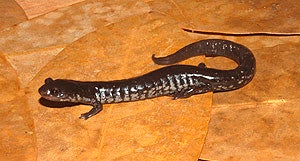SCIENTIFIC NAME:
Plethodon mississippi (Highton)
STATUS:
Formerly considered a single species, Plethodon glutinosus, these very similar species now known to be genetically distinct. At least one representative found in every county. Identification based on appearance is impossible. P. mississippi common. Coastal Plain west and north of Alabama River, including western portions of adjacent Southwestern Appalachians and Interior Plateau. Lowest Conservation Concern.
OTHER NAMES:
Originally described as the Northern Slimy Salamander (Plethodon glutinosus) and later elevated to a separate species on the basis of genetic differentiation (Highton, Maha, and Maxsons 1989). It is now a member of the Plethodon glutinosus species complex, which is comprised of 13 genetically distinct species.
DESCRIPTION:
A medium to large, terrestrial salamander about 4-6.5 inches long. Like other slimy salamanders, the Mississippi Slimy Salamander is black to bluish-black. Individuals typically have numerous white, yellow, or brassy spots on the back, tail, and sides. The degree of spotting and flecking is variable, with some individuals having few spots on the back and tail but maintaining heavy, white lateral flecking. The Mississippi Slimy Salamander generally has white spotting on the chin and throat as well. The belly is plain with few spots.
DISTRIBUTION:
The Mississippi Slimy Salamander is distributed from south-western Kentucky, through a portion of western Tennessee south through western Alabama, most of Mississippi, and a small portion of southeastern Louisiana. Mississippi Slimy Salamanders are found across western Alabama counties below the Fall Line, with some apparent overlap with Plethodon grobmani across the central portion of the state.
HABITAT:
Mississippi Slimy Salamanders are common to forested areas. Individuals can be found in maritime and river-bottom hardwood forests. Although, they are common in hardwood forests they may also be encountered in pine forests. These salamanders can utilize a range of habitats and will often be found in piles of discarded rubbish. Caves have also been reported as a habitat used by this salamander. Individuals of this species will use a number of cover objects including rotting logs, fallen branches, rocks, leaf litter, and in rock crevices.
LIFE HISTORY AND ECOLOGY:
Breeding in the Mississippi Slimy Salamander is terrestrial, with the offspring undergoing direct development (e.g. developing without a free-living, aquatic larval stage). Males will court the females using chemical, tactile, and visual cues; this likely occurs during July-August. Fertilization is internal and females will lay a cluster of 1-33 eggs that are suspended from the roof of a small cavity in the ground, under rocks and logs, and in crevices in caves and open cliff faces. Females will attend the eggs through development, 2 -3 months. Hatching will occur from August through December, depending on environmental factors. Females will remain with the young until they disperse from the nest in 2 - 3 weeks.
Adult Mississippi Slimy Salamanders are likely to establish and defend small territories from terrestrial salamanders (Mitchell & Gibbons 2010). Evidence suggests that adult Mississippi Slimy Salamanders will compete with other slimy salamanders for space (Cunningham et al. 2009). Territories are often established in and around burrows and root tunnels. The burrows serve as a refuge from desiccation during summer months, protection from predation, an area to forage, and as brooding sites. Adults will often forage at the mouth of the burrow by ambushing prey that passes by. Individuals will forage on the surface at night or during rainy periods; however, adults typically do not travel far from their burrows.
A number of predators are known to prey on Mississippi Slimy Salamanders including copperheads, garter snakes, cave salamanders, shrews, and some bird species. The Mississippi Slimy Salamander will secrete noxious, sticky mucus from glands in the tail as a deterrent. It is believed the sticky mucus deters predators due to the taste and, in effect, “glues their mouth shut” (Mitchell & Gibbons 2010).
BASIS FOR STATUS CLASSIFICATION:
The Mississippi Slimy Salamander is common within its range.
REFERENCES
Cunningham, H. R., Rissler, L. J. & Apodaca, J. J. (2009) Competition at the range boundary in the slimy salamander: using reciprocal transplants for studies on the role of biotic interactions in spatial distributions. Journal of Animal Ecology, 78, 52-62.
Highton, R., Maha, G. C. & Maxson, L. R. 1989. Biochemical evolution in the slimy salamanders of the Plethodon glutinosus complex in the Eastern United States. University of Illinois Press, Urbana.
Lannoo, M. 2005. Amphibian declines: The conservation status of United States species, University of California Press, Berkeley.
Mitchell, J., & Gibbons, W. 2010. Salamanders of the Southeast. The University of Georgia Press, Athens.
AUTHOR: Heather R. Cunningham, Alabama Partners in Amphibian and Reptile Conservation






